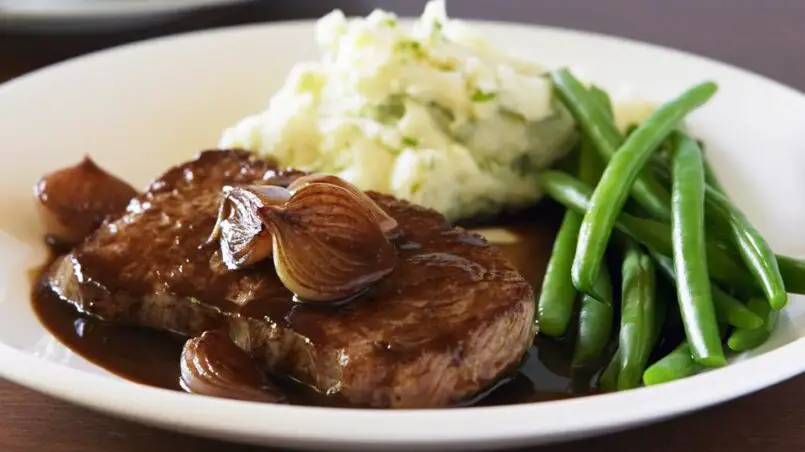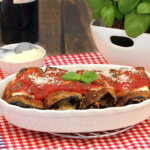A shallot is a type of bulb vegetable that belongs to the allium family. According to legend, its name derives from Ashkelon, a historic city on Israel’s coast where shallots were originally planted. On the other hand, the shallot is more likely to have originated in Central or Southwest Asia. Regardless of where they come from, shallots are the key ingredient of today’s recipe. Today we will learn how to make roasted shallot port wine reduction sauce. Let’s get down to work!
Shallots resemble little onions in appearance. They come in a variety of colors, ranging from golden brown to crimson. Their flesh is typically off-white with a green or pink hue. Because shallots are linked to garlic and onions, they have a strong and intense flavor. They are, nevertheless, mellower and sweeter than their more intense relatives. Cooking shallots make them even milder and sweeter.
The color of red wine with just a few essential ingredients will produce a shallot sauce that is easy to create at home. Shallots are a type of onion that is believed to have originated in Palestine. Shallots can be used in the same way as any other onion.
They have a softer, sweeter, and more nuanced flavor than a regular onion. They are great in sauces, salad dressings, and any dish that calls for a pinch of minced raw onion.
To caramelize the components or make it more appealing to the sauce, most of the sauce recipes on my site will call for red wine, preferably port, or another spirit. It is critical, in my opinion, to cook with wines that are good enough to drink.
When preparing superb sauces, you do not want to use cheap wine. You do not want to sabotage an $18 per pound steak by presenting it with a poor red wine sauce.
Ingredients Needed For Roasted Shallot Port Wine Reduction Sauce
- A quarter cup of vegetable oil
- One small onion, coarsely chopped 4 ounces of unstemmed mushrooms, coarsely chopped.
- One roughly chopped small carrot
- One celery rib (chopped coarsely)
- Three finely chopped garlic cloves
- Two leaves of sage
- One sprig of rosemary
- One sprig of thyme
- One and a half cups of red wine, dry
- Half of a gallon of red port wine
- Four cups of beef stock (or broth from a can)
- 2-pounds of beef tenderloin roasts, preferably from the middle
- Season with salt and freshly ground pepper.
- Two tbsp of unsalted butter, cool

Steps To Make Roasted Shallot Port Wine Reduction Sauce
- Step 1- Preheat the oven to 350 degrees Fahrenheit. In a small shallow baking dish, combine all of the ingredients. Bake for 1 hour, covered in foil. Remove the lid and bake for another 30 minutes, or until the shallots are soft and the liquid has nearly gone. Keep it aside to cool to room temperature before serving. Remove the thyme sprig and throw it away.
- Step 2- In a large saucepan, heat two tablespoons of vegetable or peanut oil. Cook over moderately low heat, occasionally turning, until the mushrooms, onion, carrot, celery, garlic, sage, rosemary, and thyme begin to brown, about 12 minutes. Raise the heat to be high, add the wine and port, and cook for 10 minutes, or until the liquid has been reduced to 1/4 cup.
- Step 3- Bring the beef stock to a boil in the saucepan. Decrease the heat to low and cook for 30 minutes, or until the liquid has been reduced to 2 cups. Into a saucepan, strain the sauce, pushing the particles to obtain as much liquid as possible.
- Step 4- Using salt and pepper, season the tenderloins. In a big pan, heat two tablespoons of oil. Brown the roasts on all sides in the skillet, smooth side down, for about 12 minutes. Spread the shallot confit on top of the roasts, soft side up. Roast the tenderloins in the skillet in the oven for about 30 minutes, or until an instant-read thermometer reads 125° for rare. Place the roasts on a carving board, loosely cover with foil, and set aside for 10 minutes to rest.
- Step 5- Cook until the pan juices sizzle in the skillet over high heat. Simmer for 3 minutes after whisking in the reserved port sauce. Remove the skillet from the heat and, one tablespoon at a time, stir in the butter until smooth. Empty the sauce into a gravy and add salt and pepper. Carve the roasts and serve them with a port sauce on the side.
Steak with Red Wine-Shallot Sauce
Ingredients
- 1-pound steak (about 1-inch thick)
- Freshly ground pepper and kosher salt
- One bowl of shallot
- Half a cup of red wine from a box
- 2–3 tablespoons of unsalted cold butter, cubed
Directions For Recipe
- Step 1- Remove the meat from the freezer 30 minutes before cooking time. Warm a big, heavy-bottomed saucepan over medium-high heat. Season the steak on all sides with salt and pepper after patting it dry. Place the steak in the pan, fat side up, and hold it with tongs for 2 minutes, or until the fat renders and the pan is slick.
- Step 2- Place the steak flat in the pan and sear for 4 to 5 minutes on one side, or until a deep brown color has developed. Cook for an additional 3 to 4 minutes on the opposite side, or until a thermometer placed sideways into the largest portion reads 120 degrees for medium-rare. Allow a chopping board to rest for 10 minutes. Keep all of the drippings in the skillet.
- Step 3- Cook the shallot in the drippings for 2 minutes over medium heat or until golden. Add the wine and use a wooden spoon to scrape out any browned bits. Bring to a boil and cook, occasionally stirring, until the liquid has been reduced by half and is somewhat syrupy for about 7 minutes; remove from the heat. To achieve a glossy sauce, whisk in the butter one piece at a time—season to taste with 1/2 teaspoon salt and 1/4 teaspoon pepper. Serve the steak with the sauce, sliced against the grain.
My Suggestion
Pre-salting, also known as dry brining, is commonly used to improve the texture of sinewy pieces of meat. However, it also enhances the flavor and juiciness of sharp cuts. It may seem paradoxical, but pre-salting beef has long been thought to dry it out. The modest salting you will be performing here, on the other hand, has the opposite effect. Water is pulled out of the flesh and then reabsorbed, resulting in a saltier, more flavourful wetness that aids in flavor intensification. In addition, the tenderloin’s surface dries up significantly, making it easier to brown in the oven.





2 Comments